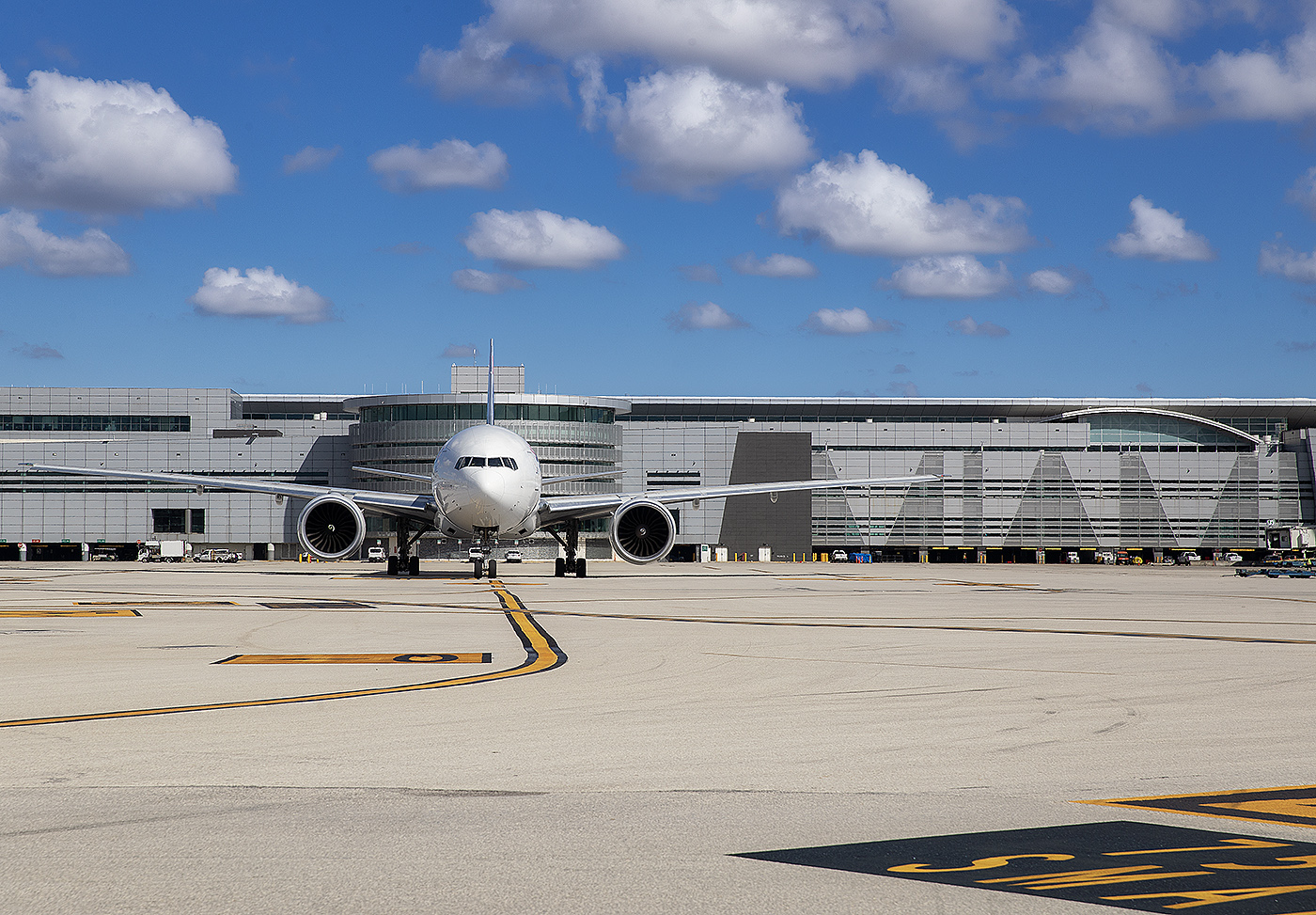The U.S. is widely known as a melting pot due to its large immigrant population and strong interest in international travel among a significant population segment. Although the U.S. State Department found that only 46% of Americans have passports, there is still enough demand for many U.S. airports to offer international flights. In 2022, the National Travel and Tourism Office (NTTO) found that 80.7 million Americans traveled outside the country, a 64% increase from the previous year.

Even though passengers can leave the U.S. from hundreds of airports, some airports are better than others. The same NTTO data found that 20.4 million Americans (25% of all American international travelers) come from five states: California, New York, Florida, Texas, and New Jersey. These states are home to the country's largest immigrant populations and cities that are important parts of the global economy. Furthermore, these states have airports with strong international connectivity.
Cities in the above five states - Miami, San Jose, Los Angeles, New York, and San Francisco - are among the world's most diverse cities by the percentage of foreign-born residents. That's not to say that these are the only good places for Americans to fly internationally from. Many other U.S. cities offer extensive flights to international destinations due to strong demand among residents and inbound foreign visitors. We will look deeper at the best U.S. airports for international travelers, using 2021 data about international passenger traffic.

John F. Kennedy International Airport (JFK)
John F. Kennedy International Airport (JFK) is North America's busiest international gateway and one of few airports worldwide to offer nonstop flights to all six inhabited continents. New York City is one of the world's most international cities, with 38% of residents being foreign-born and up to 800 languages spoken by residents. The city is known worldwide for its tourist attractions and global influence in financial services, media, fashion, and many other industries.
New York's strong clout naturally creates vast demand for international flights. Passengers can fly nonstop to international destinations on the two major American carriers with hubs at JFK: American Airlines and Delta Air Lines. Alternatively, passengers can choose from over 60 non-American carriers with direct flights to their desired destinations.

New York's outsized role as a global city means that some international airlines have JFK as their only U.S. destination. The following carriers also represent the only way to fly directly to the U.S. from their respective countries:
- Kenya: Jomo Kenyatta International Airport (NBO) on Kenya Airways
- Kuwait: Kuwait International Airport (KWI)on Kuwait Airways
- Uzbekistan: Islam Karimov Tashkent International Airport (TAS) on Uzbekistan Airways
Furthermore, JFK is the only U.S. airport with nonstop flights to certain countries, whether on an American or local carrier. Those countries include the following:
- Côte d'Ivoire: Félix-Houphouët-Boigny International Airport (ABJ) on Ethiopian Airlines
- Senegal: Blaise Diagne International Airport (DSS) on Air Senegal and Delta Air Lines

Miami International Airport (MIA)
Miami International Airport (MIA) is the second-busiest U.S. gateway for international passengers. Unlike JFK, MIA focuses on destinations in Latin America and the Caribbean. This situation is due to Miami's demographics: over 70% of the city's population identifies as Hispanic or Latino, according to the 2020 U.S. Census. Miami is also a popular destination for multinational companies interested in doing business in Latin America, with many establishing regional offices in the city.
That being said, MIA does offer direct flights to destinations in Canada, Europe, the Middle East, and Africa. Passengers can fly internationally on MIA's largest domestic carrier, American Airlines, or dozens of international airlines. Miami has become even more globally influential in recent years due to people and businesses relocating there, especially in the banking and tech industries. This means that there will be a strong demand for flights connecting destinations worldwide.

MIA offers nonstop flights to most countries in Latin America and the Caribbean. The airport is the only U.S. destination that connects the following countries:
- Bolivia: Viru Viru International Airport (VVI) on Boliviana de Aviación and Transportes Aéreos Bolivianos
- Suriname: Johan Adolf Pengel International Airport (PBM) on Surinam Airways
- Uruguay: Carrasco/General Cesáreo L. Berisso International Airport (MVD) on American Airlines
Los Angeles International Airport (LAX)
Los Angeles International Airport (LAX) is the country's third-busiest international gateway and a major connection point for travel between the U.S. and the Asia-Pacific region. Unlike MIA, LAX does not significantly focus on one region since the airport also has many direct flights to destinations across Canada, the Caribbean, Latin America, Europe, and the Middle East. The airport used to offer nonstop flights to all six inhabited continents before Ethiopian Airlines ended its service from Lomé–Tokoin International Airport (LFW) in Togo in 2019.

Los Angeles was the fourth most visited U.S. city by international travelers in 2022 and is one of the country's most international, with 36% of residents being foreign-born. The city is a global media and entertainment industry hub, making it an important business destination. Furthermore, Los Angeles' large Hispanic/Latino and Asian populations (47% and 12% of the city's population in the 2020 U.S. Census, respectively) create especially strong travel demand to Latin America and Asia.
LAX is unique because it is a hub for all three major U.S. airlines for international passengers: American Airlines, Delta Air Lines, and United Airlines. This provides passengers with many opportunities to visit international destinations on American carriers. Passengers can also fly on more than 50 international airlines, including smaller foreign carriers without a large U.S. presence.

No countries only serve LAX in the U.S. due to the airport's relative proximity to San Francisco International Airport (SFO) and Seattle Tacoma International Airport (SEA). Therefore, it makes sense for many foreign carriers also to offer nonstop flights to these two destinations. That being said, LAX would likely be one of the first U.S. destinations if direct flights to countries such as Malaysia and Indonesia were ever launched.
Honorable Mentions
New York-JFK, Miami, and Los Angeles are just some of the U.S. airports with many flight options for international travelers. The following airports are also among the top ten by international passenger traffic:
- George Bush Intercontinental Airport (IAH)
- Newark Liberty International Airport (EWR)
- Dallas Fort Worth International Airport (DFW)
- Hartsfield-Jackson Atlanta International Airport (ATL)
- Chicago O'Hare International Airport (ORD)
- Fort Lauderdale-Hollywood International Airport (FLL)
- Washington Dulles International Airport (IAD)

It should be noted that EWR and FLL are in the same metropolitan areas as JFK and MIA, respectively. This highlights the global importance of New York and Miami as tourist and business destinations. Both cities are the two most-visited U.S. cities by international travelers and are the country's two largest financial hubs.
Other U.S. airports not on the above list are good options for passengers with specific interests. Since they are located in major industry hubs, people working in the venture capital (VC) industry may benefit more from SFO and Boston Logan International Airport (BOS). Both airports offer nonstop flights to other large VC and startup hubs worldwide. Alternatively, international travelers interested in theme parks are more likely to find Orlando International Airport (MCO) useful.

Although many U.S. airports serve international destinations, some simply offer more opportunities for international flights. Passengers are less likely to be required to connect through an airport in another country from New York-JFK, Miami, or Los Angeles. This simplifies the international travel process, especially for passengers who must already do a connecting flight from another U.S. airport without direct connectivity to their desired international destination.
Memphis at Midnight: Inside FedEx's Global Superhub » Alaska Airlines Defends Home Turf with 7 Strategic New Routes for 2026 » NTSB: Maintenance Error Led to Citation CJ4 Gear Collapse in Baton Rouge »
Comments (1)
 boyarka-inform.com
I loved as much as you'll receive carried outt right here.
The sketch is tasteful, your authored material stylish.
nonetheless, you command get bought an shaakiness over that you wish be delivering the
following. unwell unquestionably come further formerly again sinjce exactly the same narly very often inside case you shield this increase. http://boyarka-inform.com/
boyarka-inform.com
I loved as much as you'll receive carried outt right here.
The sketch is tasteful, your authored material stylish.
nonetheless, you command get bought an shaakiness over that you wish be delivering the
following. unwell unquestionably come further formerly again sinjce exactly the same narly very often inside case you shield this increase. http://boyarka-inform.com/
Add Your Comment
SHARE
TAGS
INFORMATIONAL Airport JFK New York Miami MIA Los Angeles LAXRECENTLY PUBLISHED
 The Top 5 Longest Flights in the World
Technology continues to transform the way we live, work, and connect. Few industries embody this more than air travel, which has effectively shrunk the world in recent years. Journeys that would have once seemed impossible can now be completed in mere hours. Here's a look at the World's Top 5 flights, ranked by distance.
INFORMATIONAL
READ MORE »
The Top 5 Longest Flights in the World
Technology continues to transform the way we live, work, and connect. Few industries embody this more than air travel, which has effectively shrunk the world in recent years. Journeys that would have once seemed impossible can now be completed in mere hours. Here's a look at the World's Top 5 flights, ranked by distance.
INFORMATIONAL
READ MORE »
 Top 5 Unique Gifts for Pilots & Aviation Lovers Under $50
Discover five budget-friendly aviation gifts for under $50, ranging from stylish polarized aviator sunglasses and airplane pattern ties to practical VFR sectional flashcards. This curated list offers the perfect mix of professional utility and industrial decor for every pilot and flight enthusiast.
STORIES
READ MORE »
Top 5 Unique Gifts for Pilots & Aviation Lovers Under $50
Discover five budget-friendly aviation gifts for under $50, ranging from stylish polarized aviator sunglasses and airplane pattern ties to practical VFR sectional flashcards. This curated list offers the perfect mix of professional utility and industrial decor for every pilot and flight enthusiast.
STORIES
READ MORE »
 Memphis at Midnight: Inside FedEx's Global Superhub
When considering major hub airports in the United States, few might think of Memphis International Airport (MEM). This facility, which is only the second busiest in Tennessee based on passenger volumes, might not boast an impressive flight schedule from passenger airlines. However, across the airfield from Memphis' passenger terminal, FedEx has turned the airport into a critical cargo superhub. In fact, between the hours of 10:00 PM and 5:00 AM, Memphis becomes the busiest airport in the world.
INFORMATIONAL
READ MORE »
Memphis at Midnight: Inside FedEx's Global Superhub
When considering major hub airports in the United States, few might think of Memphis International Airport (MEM). This facility, which is only the second busiest in Tennessee based on passenger volumes, might not boast an impressive flight schedule from passenger airlines. However, across the airfield from Memphis' passenger terminal, FedEx has turned the airport into a critical cargo superhub. In fact, between the hours of 10:00 PM and 5:00 AM, Memphis becomes the busiest airport in the world.
INFORMATIONAL
READ MORE »


